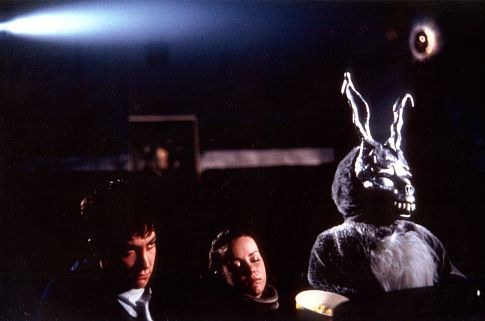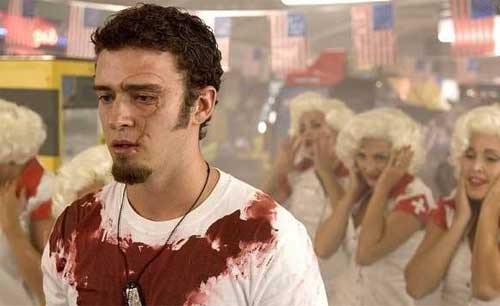So what is "New Queer Cinema"? Simply put it's a genre coined by the academic B. Ruby Rich in an issue of “Sight &
Sound Magazine in 1992 as a way to encapsulate the rise in “queer-themed
independent filmmaking” of the early 90’s and can be seen as an umbrella term
for LGBT film making from 1990 to present.
To best explain the history of this era of LGBT cinema it no
doubt best to look at LGBT cinema as a whole especially as LGBT cinema has
unquestionably existed before the rise of this definition with film scholars citing
both “The Fall of the House of Usher (1928) and “Lot in Sodom” amongst the
earliest examples though the LGBT film making in this period was largely a
closeted affair with films often being made to masquerade as hetrosexual fare
for the mass-market while throwing in the occastional subtle wink to its true
audience. Openly gay or lesbian characters meanwhile were used mainly as
punchlines or characters destined for a tragic demise which would essentially
continue to 1969 though examples can be found throughout the postwar American
avant-garde cinema with directors such as Kenneth Anger, Gregory Markopoulos
and the unquestionably most well-known Andy Warhol. At the same time European
arthouse cinema was being populated by the likes of Jean Genet’s “Un Chant
D’Amour which would prove to be a major influence for New Queer Cinema’s pioneer
Todd Haynes whose “Superstar: The Karen Carpenter Story” and more key “Poison” which
would be responsible for essentially kick-starting the sub-genre.
The Stonewall Riots of June 27, 1969 not only provided the
catalyst for the LGBT civil rights movement but also LGBT cinema aswell with a
large number of film festivals dedicated to Gay and Lesbian cinema being
established for films which were either largely experimental or documentary
based such as Milton Miron’s “Tricia’s Wedding. At the same time European
cinema continued to provide its own unique brand of film making such as Ron
Peck’s “Night Hawks” and Stephen Frear’s double header of “My Beautiful
Laundrette” and “Prick Up Your Ears brought forth a new era of frankness while
addressing the climate of Margaret Thatcher’s Britain of the late 80’s.
Unsurprisingly “New Queer Cinema” would be born out of the rise
of the same independent film making scene which via Steven Soderbergh’s “Sex,
Lies and Videotape” had started to see films
from this scene starting to gain attention from the studios while for the film
makers despite working with much smaller budgets than their studio counterparts
found a freedom to express and create the films they wanted, making it the
perfect breeding ground for the movement to take root with 1991 and 1992 being
the key years in which LGBT film making really began to get noticed despite the
likes of Gus Van Sant’s “Mala Noche” and Bill Sherwood’s “Parting Glances”.
Sherwood’s film being especially notworthy for not only featuring the acting
debut of Steve Buscemi as Nick a gay man living with aids in New York while
being cared for by his ex-lover. The film sadly would be Sherwood’s only film
due to losing his own battle with the disease but should be also noted as being
one of the first to deal with the realities of aids in the face of the hysteria
of the newspaper headlines and government propaganda.
Despite these films certainly making inroads in the mid 80’s
thanks to their success with critics though were hampered by limited releases.
They should however still be considered as being as important to the movement
even if it wouldn’t be for another four years that the movement would really
find its feet. Amongst the first films
to be cited under this new definition by Rich were “Poison” Todd Haynes which
would win the 1991 Sundance festival Grand Jury Prize for Best Film followed by
Tom Kalin’s “Swoon” and cinematic agitator Greg Araki’s “The Living End” all
showcasing an exciting new and fresh voice for LGBT cinema.
The films which formed this new era of LGBT cinema were
unapologetic in their approach to the portrayal of the LGBT lifestyle assuming
that they their audience were members of this community and hence there was no
need to “explain” either homosexuality or lesbianism to their audience. At the
same time they cared little aswell for presenting the politically correct image
of the community with the likes of “Poison” featuring pretty graphic depiction
of sexual relationships between prision imates while Greg Araki reworked the
chase movie to feature two young and HIV-positive men. These directors aiming
not to push the sexuality of its characters but essentially demand that LGBT
culture be acknowledged despite society at this period of time being keen to
largely repress let alone acknowledge the community.
These films would open a gateway for not only similar films
but also bringing forth a new openness which saw films such as Kimberly
Peirce’s “Boys Don’t Cry” and Jamie Babbit’s “But I’m a Cheerleader” being
produced which would likely not have happened had it not been for the success
of their New Queer Cinema forefathers. By 2001 the Sundance Film Festival again
would serve as marking the next evolution for the genre with the musical
“Hedwig and the Angry Inch” wining the “Audience Award for Best Film” and the
mainstream sucesss of “Brokeback Mountain” marking the genres merge with
mainstream film making that we continue to see today with the likes of “Behind
the Candelabra” and “Blue is the Warmest Colour” making it all those early
films of this movement all the more relevant.
Superstar: The Karen Carpenter Story – Todd Haynes debut short film based on the final seventeen years of Karen Carpenter’s life with all the parts played by Dolls which Haynes modified to tell her story, including whittling the arms and face of the Karen doll to show her anorexia.
Banned due to a copyright lawsuit filed by Karen’s brother,
the film still turns up on VHS as well as youtube leading to it regularly being
named amongst the top 50 cult movies of all time.
C.R.A.Z.Y. – The legend goes that nearly everyone in Quebeck- a population of around five million – has seen this film and its easy to understand why as Jean-Marc Vallee crafts an entertaining and occastionally tale which is as much about family disfunction and the things which tie them together as it is about sexual awakening. Something which perhaps has put more people off seeing this sadly much overlooked film.
Paris Is Burning – Often referred to as being one of the
most important documentaries in Queer cinema history as director Jennie
Livingston chronicles the ball culture of New York City, where contestants are
required to give catwalk style walks while being judged on their dancing and
outfits. The documentary also explores many of the contestants deal with issues
such as racism, homophobia, AIDS and poverty, making it an important snapshot
of the period.
Nowhere – One of the more accessible films from Greg Araki
but still retaining all his usual oversexed randomness as it follows a group of
LA teens over the course of a frenzied 24 hour. A day made up of a volatile
cocktail of sex, drugs, suicide, bizarre deaths and alien abduction
The final film in his “Teenage Apocalypse Trilogy” which
includes “Totally Fucked Up” and “The Doom Generation”, a trilogy based on
shared themes rather than reoccurring characters, while this film also boasts
one of the most impressive before they were famous casts since “Clueless”.
Fox and His Friends aka Right Fist of Freedom – written and
directed by Rainer Werner Fassbinder who also stars as the titular Fox a
working class gay man who falls for the older and wealthier Max who initially
wants nothing to do with Fox until he wins the lottery. However it soon becomes
clear that Max does not share Fox’s feelings as he plots to swindle him out of
his newly gained fortune.
Fassbinder is unquestionably a key source of inspiration for
many directors who contributed to the New Queer Cinema movement while equally
been an important figure in New German Cinema aswell. Here he goes against the film making norms by
portraying his gay characters as being normal rather than being a problem while
showcasing that his letcherous homosexuals were really no different than any
other films lecherous hetrosexuals.


























Great write up, Teenage Apocalypse Trilogy is one of my favorite series of films.
ReplyDelete